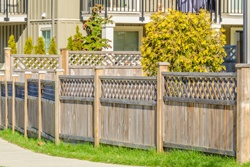Wood
Wood fences are the most popular type of fence and have been around the longest. The type of style and range of colors are unlimited, and wood is a renewable resource if it has been sustainably harvested. The initial cost of a wood fence is much less than vinyl or composite, and if well-constructed, a wood fence will last for many years. Wood fences do require more maintenance than other types of fences. They need to be rinsed off on a regular basis and will need to be repainted or stained every 3-4 years. The upkeep cost of a wood fence will likely make it equal to or more expensive than the other types of fences.
Vinyl
Vinyl is available in a wide variety of styles, colors and finishes. It is pretty low maintenance as it does not need to be repainted, and it won’t warp, splinter, rot or blister. It’s also easy to clean with a hose and sponge or pressure washer. The cost of vinyl is higher upfront, but homeowners will likely save money in repairs and maintenance costs over time. The plastic appearance of vinyl does not appeal to everyone and is not considered environmentally-friendly – difficult to recycle and toxins are released in manufacturing process.
Composites
Composite fencing is made from engineered wood and is offered in a wide variety of styles and made with recycled fibers, plastics and binding agents. Like vinyl fencing, they do not require stain or paint and are low maintenance and durable. Unlike vinyl, composite fencing is considered environmentally friendly because up to 95% of the materials used in the manufacturing process are recycled, but composite products cannot easily be recycled at the end of their life. Composite fencing offers fewer styles than vinyl or wood, the material is susceptible to scratching, staining and fading and the composite boards are about twice as expensive as pressure-treated wood.
Ornamental Metal
Many people see ornamental metal as the best combination of the other available fence materials. It is available in a variety of styles, very low maintenance and very durable. Today the metal is often made from powder-coated galvanized steel, aluminum or a combination of aluminum and solid metal – cast iron was often used in the past. Maintenance includes hosing the fence occasionally. If any rust appears, it can be brushed off and repainted. Metal fencing can also be recycled easily. Metal fences are pretty resistant to damage, but if a metal fence needs repairs, they can be challenging.
Steel Chain Link
Chain-link is the most popular type of steel fencing. It’s not the most attractive fencing option, but it can be used effectively in a garden or if a homeowner wants a see-through fence option. Chain-link is maintenance free, durable, economical, and easy to install and repair. Chain-link is also considered a “green” choice because a scrap metal dealer will be happy to pay you for what you are discarding and will recycle it in some way. Chain-link fencing does offer some variety with different sizes and wire gauges available along with coatings in a variety of colors.
Once you have helped your client select the best material for his or her fence, it’s important to use quality tools in the construction process that will save you time and money and maximize your client’s satisfaction. The Fence Stapler from FASCO America®, Master Distributor for the BECK Fastener Group®, is a powerful, pneumatic stapler used for driving in 1-9/16” staples in aged hardwood and pressure-treated posts. To read more about building the perfect fence, download our whitepaper.
.svg.png)


